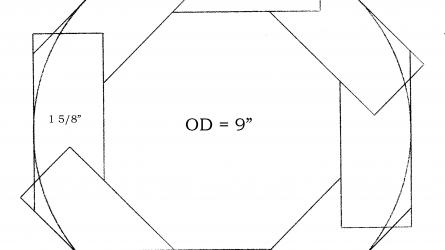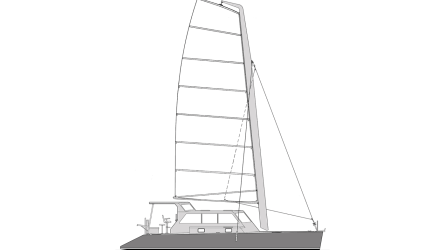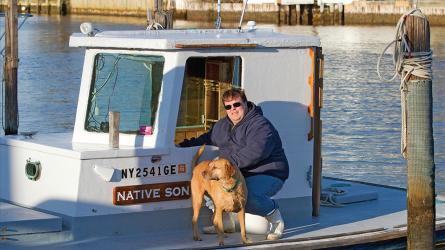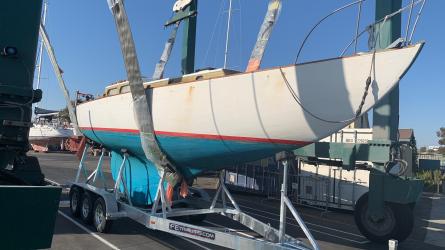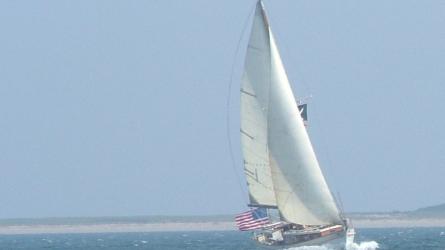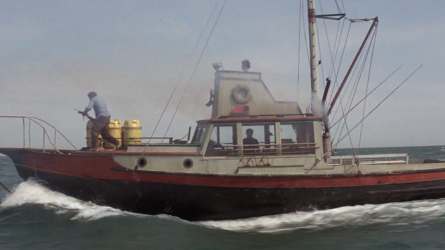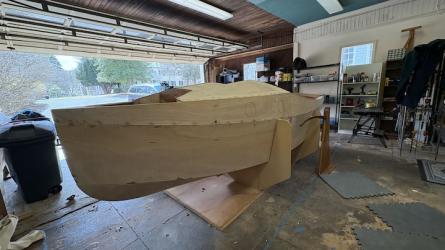LA VIE EN ROSE
A collaborative masterpiece by owner, designer, and builder
A collaborative masterpiece by owner, designer, and builder
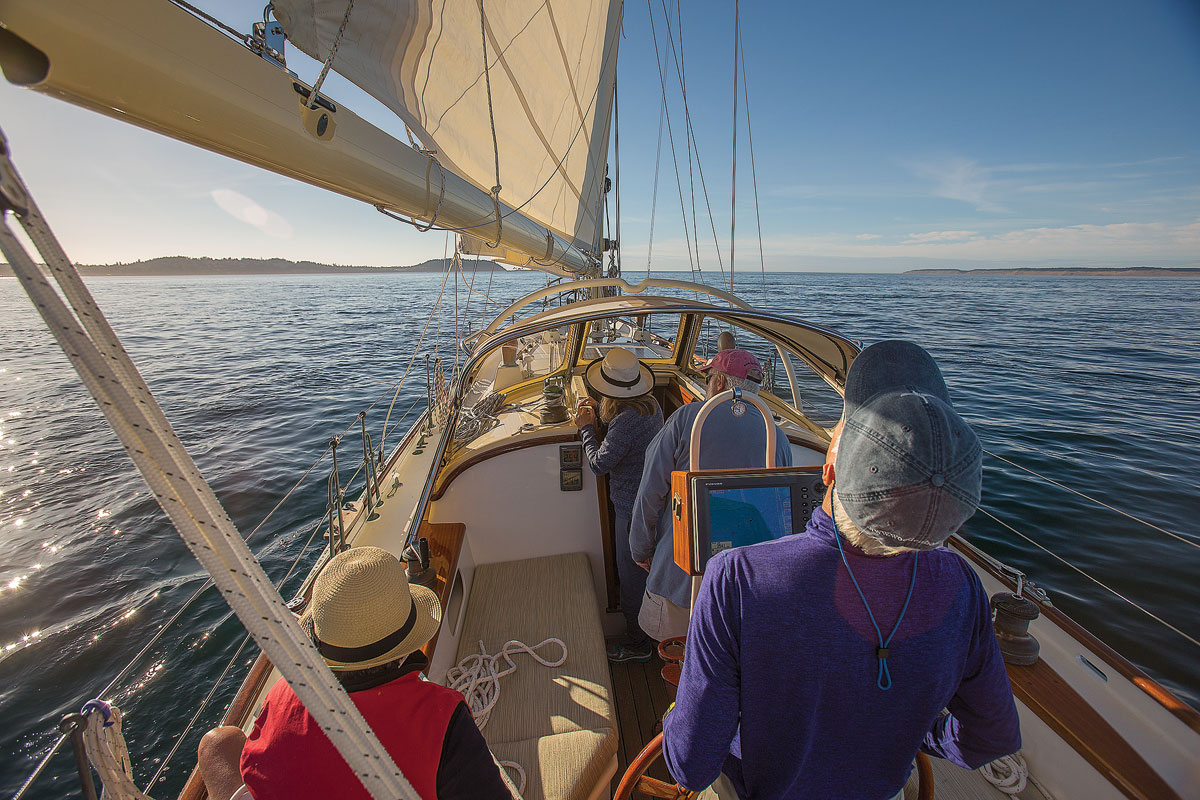
The Lessers intended their boat for cruising in Puget Sound and the Inside Passage in their retirement.

The journey from concept to reality was a long one for David and Rosemary Lesser and their yacht’s designer, Paul Gartside, but patience and clear communication brought LA VIE EN ROSE to fruition. She was launched at Jespersen Boat Builders in Sidney, British Columbia, in 2012.
When I first saw the 40′ yawl LA VIE EN ROSE at the Port Townsend (Washington) Wooden Boat Festival, she stood out among the flotilla of beautiful boats, with her elegant canoe stern terminating a distinctive blue-green hull. Aboard, her bright interior had unique details that come only with a custom-built wooden boat. What stands out most in my memory, however, is the pride of LA VIE EN ROSE’s owners, Dave and Rosemary Lesser, who showed me the wonders of their boat with an almost giddy amazement that they had initiated the creation of something so perfectly beautiful and functional. The Lessers were like fawning parents introducing a prodigy child—they had conceived the boat but were nonetheless a bit surprised at the wonderful end result.
Although the Lessers had in mind the initial concept for LA VIE EN ROSE, it was yacht designer Paul Gartside who took their initial wish list and turned it into a design on paper over a period of three years. Of equal importance was Jespersen Boat Builders of Sidney, British Columbia, Canada. The yard worked with Gartside and the Lessers to turn the design into a carefully crafted sailboat. The story of these three influences is not one of flamboyant personalities or dramatic decisions but rather a long and patient process progressing from the Lessers’ imagination to the unique yacht with which they now explore Pacific Northwest waterways.
The Wish List
Dave Lesser’s letter to Gartside in March 2005 was a first attempt to explain the vague concept of his dream boat. There were a few specifics: “The shower should be separate from the head…. The number of through-hulls should be minimized.” But the general parameters can be summarized in four points: The boat had to be easily handled by an elderly or shorthanded crew; it had to sail well; its systems should be uncomplicated; and it should have classic good looks.
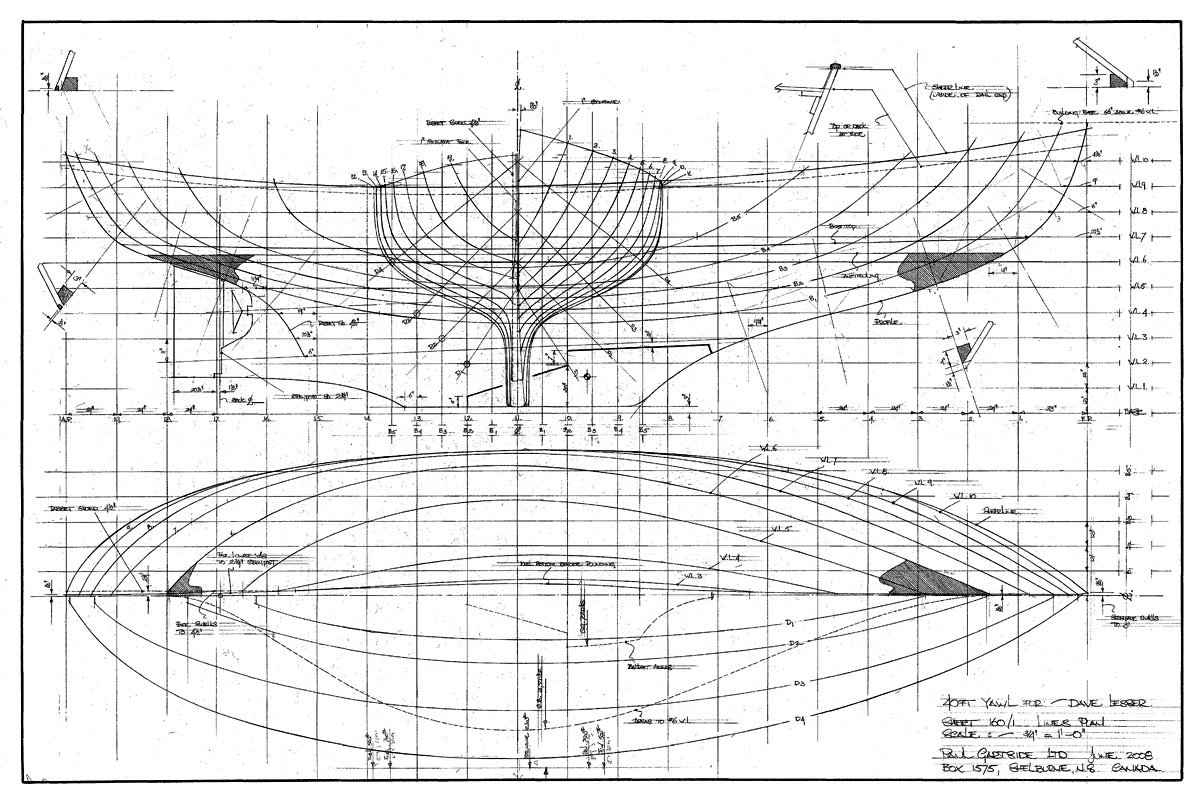
COURTESY OF PAUL GARTSIDE
Attracted by the canoe yawls WENDA by Albert Strange and ROZINANTE by L. Francis Herreshoff, Dave Lesser hoped to sway designer Paul Gartside to similar ideas for his new boat. Gartside, however, felt that the various imperatives imposed on the design would not fit the overall profile and size of those earlier boats. Having designed numerous double-enders and cruising boats himself, he advocated something larger. The resulting 40′9″ LOA cold-molded hull retained a hint of the canoe-yawl stern but accommodated the various needs the clients expressed. It did, however, meet one criterion that the clients and designer could both easily agree upon: it had to be beautiful.
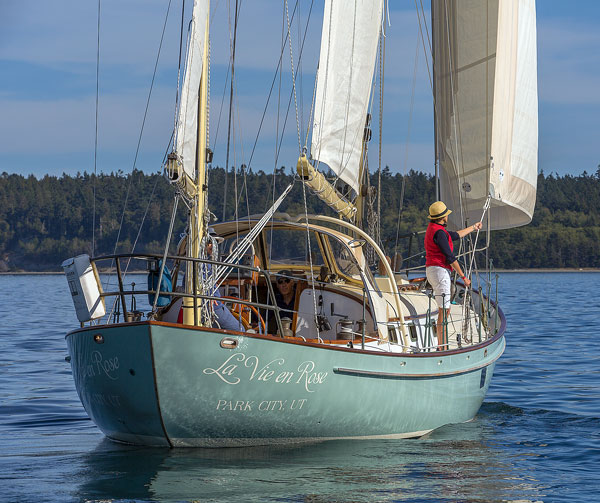
Wide side decks, a comparatively easy-to-handle rig, and comfortable cockpit and belowdeck spaces were important to the Lessers. Dave Lesser didn’t want to reach the point, as his father did, where he would have to think twice about whether his boat would be too much for him to handle in the years ahead. The strongly cambered cabin roof provides ample headroom below without appearing disproportionate.
The first criterion came directly from Lesser, who witnessed his own father’s reluctant retirement from sailing as he grew older and less able to handle the physical demands of the Lyle Hess–designed cutter he owned. The Lessers, both U.S. Air Force doctors, were nearing retirement and recognized that building LA VIE EN ROSE could take years. “No. 1 on the list was to have some longevity [with the boat],” Lesser says. “We didn’t want to build the boat and then five years later say, ‘Oh we can’t do this anymore.’”
Ease of use also dictated the hull’s overall length. The Lessers had initially envisioned a boat of 36′ to 38′. As the emails went back and forth between clients and designer, often with several months between correspondence as other obligations interceded, the specification increased slightly, finally settling at 40′9″ overall.
Accessibility for an aging crew also resulted in LA VIE EN ROSE’s wide side decks, a cockpit that would permit easy access, and the surprisingly shallow descent of just two steps from the cockpit to cabin. Her yawl rig, besides giving the boat a classic look, would divide the sail plan and make the sails comparatively easy to handle.
The second point on Lesser’s list to Gartside—that the boat had to perform well—came from his love of sailing. He didn’t have extensive experience in sailing large boats, aside from some chartering in the Caribbean, but he had owned a Herreshoff 12½ and had done quite a bit of small-boat sailing. Rosemary had done very little sailing but enjoyed what she had experienced.
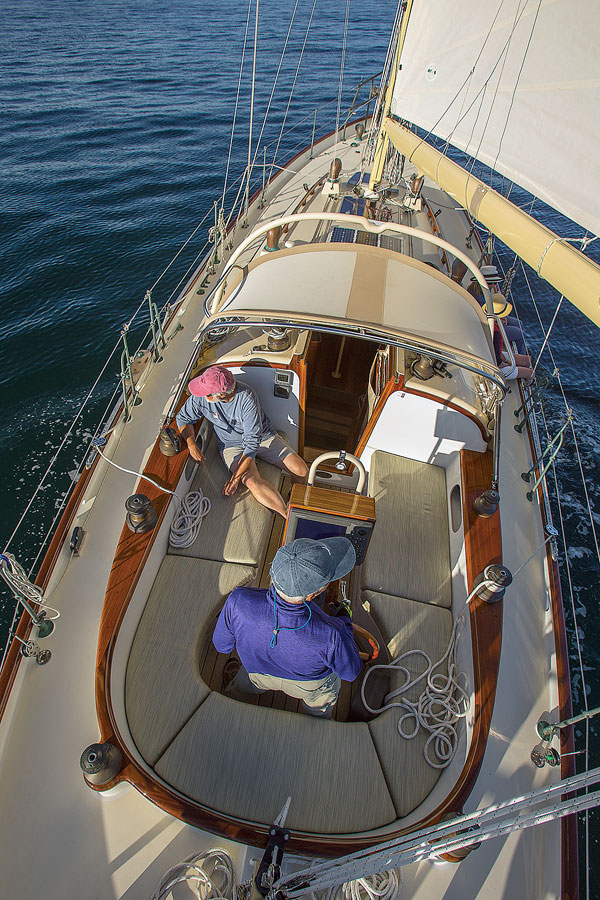
The cockpit is comfortable and spacious, with ease of access the top priority. It has only two companionway steps down into the cabin, and a coaming wide enough to sit on yet low enough to step over easily.
The third point, emphasizing simple systems, stemmed from Lesser’s earlier career as an engineer and his understanding of the amount of work it would take to maintain a complicated boat. “I favor a minimalist approach, with few distractions from the experience of being underway on the water,” he wrote.
And the final requirement—good looks—came from Lesser’s appreciation of wooden boats. “When it comes to boats, Dave Lesser is a romantic through and through,” Gartside recalled in Mike O’Brien’s 2011 review of the design in his Boat Design Quarterly (No. 36). “WENDA and ROZINANTE were the initial inspirations from an aesthetic standpoint,” Lesser says, referring to canoe yawls designed, respectively, by Albert Strange in 1899 and L. Francis Herreshoff in 1952. “I’d have loved to have WENDA, but big enough to live on.”
This appreciation of classic wooden boats was what led Lesser to Gartside, a designer known for producing yachts with classic lines and rigs. Gartside is an experienced builder, which Lesser felt was an important skill for a designer to have. It also helped that, at the time, Gartside was located in Sidney, a boatbuilding center on Vancouver Island that is relatively close to the Lessers’ home base in Utah and close to the Jespersen yard. (Gartside has since moved twice, first to Nova Scotia and then to New York.)
During the summer and fall of 2005, Lesser sent Gartside sketches and photographs illustrating the various qualities—both specific and general—that his ideal yacht should include. One interesting detail was Lesser’s desire to have a comfortable place to sit. Specifically, he noted a chair design described and sketched in a book he had encountered: A Somewhat Irreverent Look at the Design of the Long Distance Cruiser, by Bill Rothrock (Wilson Stone, Costa Mesa, California, 1974).
“I hope that through these materials, I am able to communicate my vision for this project,” Lesser wrote to Gartside in November 2005, “and I trust that you will identify those ideas that are unrealistic, unworkable, or unwise.”

The spacious galley is within easy communication range of the cockpit and well organized for living aboard. The cookstove, which uses diesel fuel, is vented through the cabintop.
Nailing Down the Details
Lesser’s original plan was to have the new boat’s hull and deck constructed by a professional yard and then to finish off the rigging, the boat’s systems, and the interior himself. In fact, he had already been collecting bits of bronze hardware he found on eBay in anticipation of fitting out the finished hull. However, after a year of communication with Gartside even the basic sail plan and profile had yet to be agreed upon between designer and client. “Dave comes at things in a methodical way,” Gartside said when I called him at his current home on Long Island. “He is a very rational thinker.”
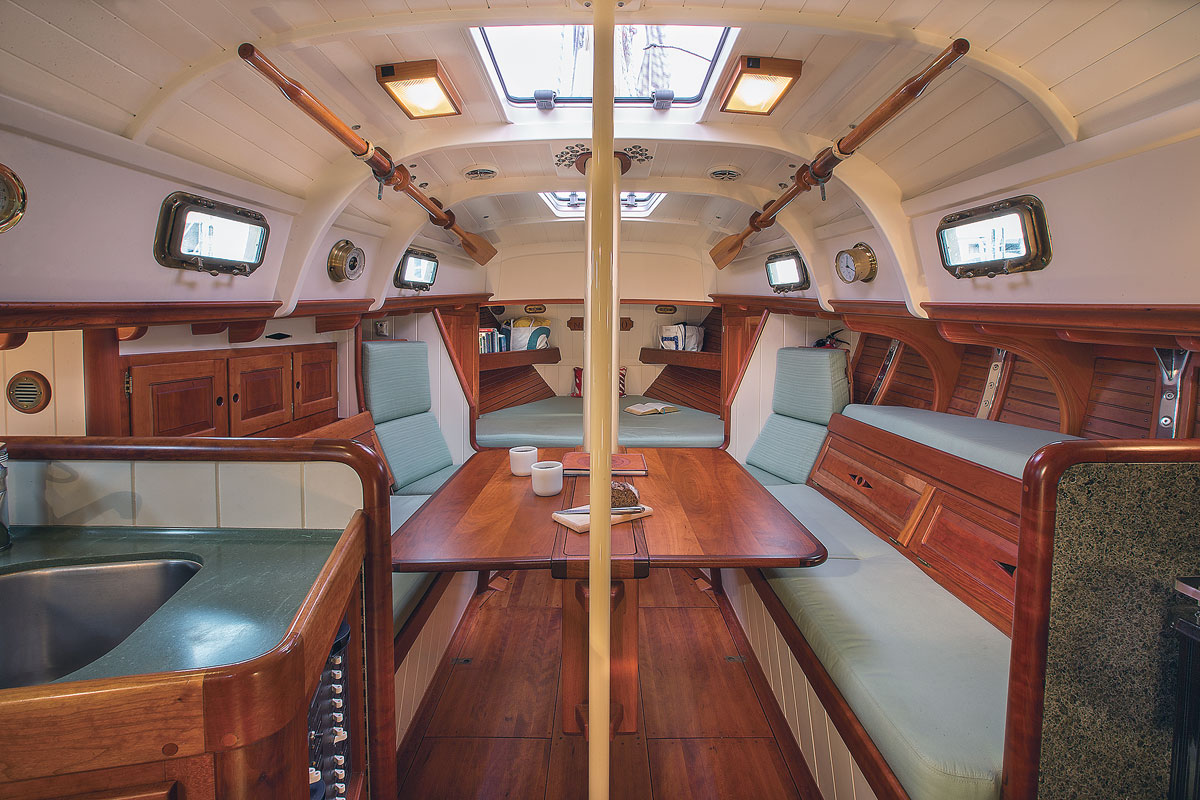
LA VIE EN ROSE has minimal bulkheading, which makes the cabin spacious and inviting. Intended for a couple to cruise in comfort for considerable time, the yacht has a V-berth forward. The saloon is set up for sociable seating around the dropleaf table when guests are aboard. Of particular note are two nearly face-to-face, very comfortable seats placed forward of the settees—perfect for reading or conversing—inspired by a book that was critical of cruising sailboats without comfortable places to sit.
In June 2006, after Lesser proposed an additional tweaking of Gartside’s sketches of the stern and the trunk cabin profiles, it appeared that client and designer had reached an impasse. “I think we have a basic problem here that I am not drawing a boat that you like,” Gartside wrote; “...boats are more than the sum of their parts…. They have to contain as many of the features we want as can be reasonably achieved, and they have to perform properly, but the crucial thing is that the overall package hangs together and looks and feels right. It’s a hard thing to define, but it’s usually very clear when the boat is launched whether it has it or not.”

Given the rainy and cool Pacific Northwest weather, particularly in the spring and fall, a heating stove is essential. The custom cast-iron diesel stove is by Navigator Stove Works, which is based on Orcas Island, Washington.
When I talked to Gartside, he fondly remembered working with Lesser. He appreciated his engineering exactness, his romantic admiration of classic boats, and the kindness of both Dave and Rosemary. He did, however, remember this difficult moment in the design process. “I didn’t think I was going to be able to give him what he wanted,” he recalled.
Gartside’s frank proposal of putting the whole project aside for a while or possibly forever had an immediate effect on Lesser. “When I first started thinking about this project,” he wrote to Gartside, referring specifically to the new design’s coach roof profile, “I was influenced by Herreshoff’s ROZINANTE and Strange’s WENDA, and I also took cues from your pilothouse cutter that was featured in WoodenBoat in 1991,” referring to a WB No. 102 design review by Joel White of a 42′9″ Gartside cutter. “But the more that I look at it, the more I realize that you’re right—it doesn’t fit. I now understand your point about a boat being more than the sum of its parts and that you can’t design a boat by cutting and pasting individual features. So from now on,” Lesser concluded, “I’ll view this boat as a unique creation and not some reincarnation of the past.”
At that point, LA VIE EN ROSE’s design took on a life of its own. It was no longer merely a copy of an earlier design. (In fact, some of the early sketches Lesser sent to Gartside were simply enlarged profiles of ROZINANTE). From then on, LA VIE EN ROSE evolved, with Gartside’s guidance, from the Lessers’ inchoate wish list to become a masterpiece in its own right.
Off to the Yards
After Lesser’s revelation regarding the uniqueness of his new boat, the design continued to progress but there were still many details to work out. Four more years would pass, documented in the many correspondences between Lesser and Gartside, before construction could begin.
“At the time,” Lesser wrote to me in an email, “I was reading everything I could about design. In retrospect, my letters to Paul were attempts to work through various design concepts in my own head. Paul was very patient to have waded through all of my wordiness, and it is a testament to him that the design turned out so well.”

Spaciousness and light contribute to LA VIE EN ROSE’s liveaboard appeal. Natural light floods the cabin through two skylights, ample portlights in the cabin sides, and four ports (not visible here) in her topsides. The cabinetwork is cherry, crafted by the crew at Jespersen Boat Builders.
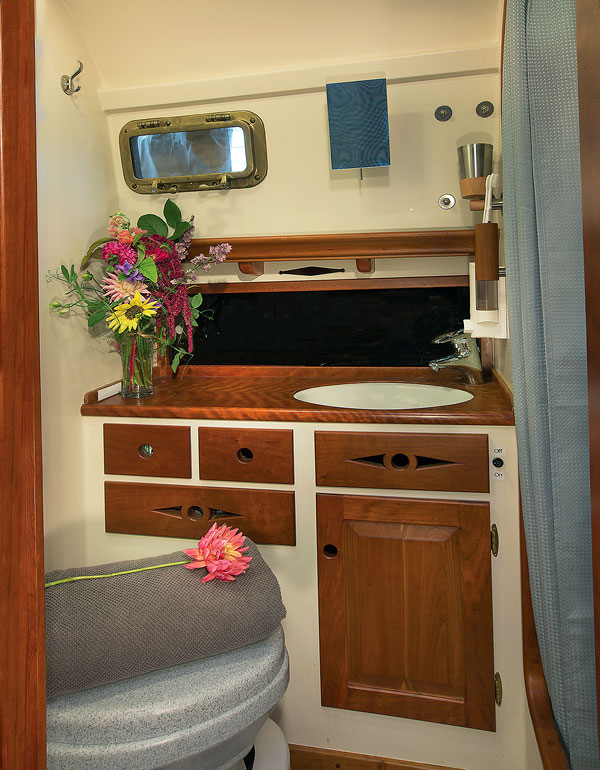
The head is to starboard, opposite the galley, with its own shower stall, the curtained opening for which is visible at the right. A composting toilet was one of the Lessers’ requests, with the goal of keeping systems as simple as possible.
Another development came when the Lessers realized that by postponing retirement and working a bit longer they could afford to pay a yard to build the boat from start to finish rather than having Lesser finish off the hull as he had at first contemplated.
The obvious choice for a yard, especially once the Lessers decided that cold-molding would be the construction method, was Jespersen Boat Builders in Sidney (see WB No. 136). The Jespersens have been building boats in Sidney since 1974—first under the guidance of Bent Jespersen and now under his son, Eric, who is accomplished not only as a builder but also as a competitive sailor, who counts among his victories a 1992 Olympic bronze medal in Star-class racing. For many years, the yard has built boats to Gartside’s designs.
“I always enjoy working with the Jespersens,” Gartside says. “And if I make a mistake, they correct it,” he jokingly adds. Lesser felt that just as it was invaluable to have a designer with building experience, so it would be to have a builder with sailing experience.
When Eric Jespersen first saw the design of LA VIE EN ROSE, he wasn’t immediately impressed. “The double-ender [design] makes it small, and the yawl rig makes it smaller yet,” he recalled of the project when I talked with him over the phone. But as construction progressed and the boat ultimately made it to the water, Jespersen came to appreciate the well-thought-out design more and more.
“It’s often challenging to keep a sheer looking good on a canoe yawl,” Jespersen says. “They did well. Paul is a very clever guy with a good eye. The judge of that is David’s satisfaction.”
LA VIE EN ROSE’s construction took nearly two years—two years of a developing relationship between owner and builder following an already extensive relationship between owner and designer. “There is a tremendous amount of faith [in building a custom boat],” Jespersen says. “The builder has never been on or seen the boat, nor has the customer.” As a custom builder, Jespersen is well aware that he is not just selling a boat: “The process is what you are selling,” he says.
The hull was cold-molded with six layers of 3/16″-thick western red cedar glued up on the diagonal with a final, exterior longitudinal layer of 5/16″-thick Douglas-fir. The hull was sheathed with fiberglass cloth set in epoxy, using 17-oz cloth over the keel and deadwood and 9-oz over the rest of the hull. This method posed no new challenges for the crew at Jespersen Boat Builders, although Jespersen remembers some difficulties which may have rattled a customer without Lesser’s unflappable patience—not least of which was the 2008 economic collapse, just before construction began. Another challenge was the fact that Jespersen Boat Builders moved their shop to a new location midway through the construction, delaying the completion. But the LA VIE EN ROSE project weathered these setbacks.

Dave Lesser had very particular ideas about what he wanted in a boat, and he was involved in every detail of LA VIE EN ROSE’s design and construction. He built the steering wheel and pedestal himself. The bronze hardware that he had collected was incorporated into the deck layout, complemented by a custom bronze stern pulpit.
As the boat neared completion, every finish detail was carefully considered by the Lessers, Gartside, and the Jespersen yard. Sailmaker Carol Hasse of Port Townsend was consulted on the sail plan and then commissioned to build the sails. The unique, cambered cabintop took shape as a complex cold-molded lamination, giving a surprising amount of headroom below while maintaining a comparatively low profile at the sides. Lesser built the steering wheel and pedestal himself and was able to integrate much of his bronze hardware collection into the deck layout. Blending off-the-shelf colors for a unique tint, he had a custom paint made for the hull.
Interior lockers were constructed in cherry by Jespersen’s crew, including the Frenchman Michel Gaudin, who became one inspiration for the boat’s French name. A port and starboard pair of seats—based on Rothrock’s idea of perfect proportions—took shape, ensuring there would be at least two comfortable places to sit belowdecks.
The boat’s name, which translates as “to see life through rose-colored glasses,” was an oblique nod to Rosemary’s first name, Gaudin’s craftsmanship, and Lesser’s optimistic worldview.
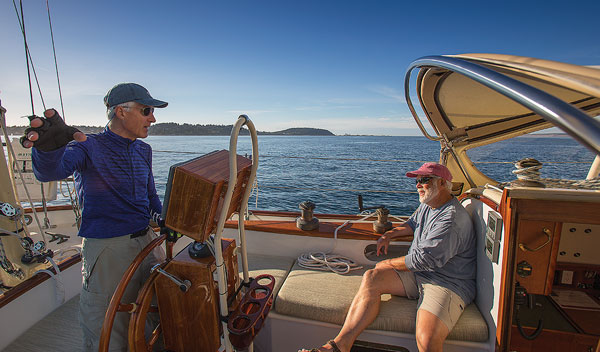
The Lessers, who cruise seasonally in Washington and British Columbia, occasionally with guests, will enter their sixth season with the yacht in 2018.
The Final Masterpiece
Finally, on September 17, 2012, after more than seven years of design work and construction, LA VIE EN ROSE was launched in Sidney’s Canoe Cove. “It was built to be a capable offshore boat,” Lesser says. “But, for now, we’ve decided that we really like coastal cruising.” With experience, the boat “has gotten better and better as we’ve spent time on it,” Lesser says, looking back on the past five summers of cruising the Puget Sound and the Inside Passage in Washington and British Columbia.
After learning of the Lessers’ story and hearing of their multiyear relationships with both the designer and the builders of LA VIE EN ROSE, I thought back to my first meeting with them in Port Townsend. It was obvious that their pleasure in the finished boat wasn’t an accident or due to a stroke of good luck. Rather, this masterpiece had been created from the Lessers’ idea of a dream boat and brought to fruition through the hard work of a skilled designer, an experienced builder, and a determined but patient owner. 
Bruce Halabisky is a boatbuilder and sailor living on Orcas Island in Washington State’s San Juan Islands. He is a frequent contributor to WoodenBoat.
